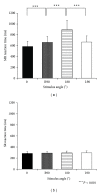Immediate beneficial effects of mental rotation using foot stimuli on upright postural stability in healthy participants
- PMID: 24459588
- PMCID: PMC3888733
- DOI: 10.1155/2013/890962
Immediate beneficial effects of mental rotation using foot stimuli on upright postural stability in healthy participants
Abstract
The present study was designed to investigate whether an intervention during which participants were involved in mental rotation (MR) of a foot stimulus would have immediate beneficial effects on postural stability (Experiment 1) and to confirm whether it was the involvement of MR of the foot, rather than simply viewing foot stimuli, that could improve postural stability (Experiment 2). Two different groups of participants (n = 16 in each group) performed MR intervention of foot stimuli in each of the two experiments. Pre- and postmeasurements of postural stability during unipedal and bipedal standing were made using a force plate for the intervention. Consistently, postural sway values for unipedal standing, but not for bipedal standing, were decreased immediately after the MR intervention using the foot stimuli. Such beneficial effects were not observed after the MR intervention using car stimuli (Experiment 1) or when participants observed the same foot stimuli during a simple reaction task (Experiment 2). These findings suggest that the MR intervention using the foot stimuli could contribute to improving postural stability, at least when it was measured immediately after the intervention, under a challenging standing condition (i.e., unipedal standing).
Figures




Similar articles
-
Improvement of Postural Stability During Quiet Standing Obtained After Mental Rotation of Foot Stimuli.J Mot Behav. 2016 Jul-Aug;48(4):357-64. doi: 10.1080/00222895.2015.1100978. Epub 2016 May 9. J Mot Behav. 2016. PMID: 27162153
-
Embodied Mental Rotation - Does It Affect Postural Stability?J Mot Behav. 2023;55(2):202-219. doi: 10.1080/00222895.2022.2151970. Epub 2022 Dec 6. J Mot Behav. 2023. PMID: 36473703
-
Auditory cues behind congenitally blind subjects improve their balance control in bipedal upright posture.Gait Posture. 2019 May;70:175-178. doi: 10.1016/j.gaitpost.2019.03.004. Epub 2019 Mar 7. Gait Posture. 2019. PMID: 30878728
-
Challenging Postural Tasks Increase Asymmetry in Patients with Parkinson's Disease.PLoS One. 2015 Sep 14;10(9):e0137722. doi: 10.1371/journal.pone.0137722. eCollection 2015. PLoS One. 2015. PMID: 26367032 Free PMC article. Clinical Trial.
-
Immediate beneficial effects of self-monitoring body movements for upright postural stability in young healthy individuals.J Bodyw Mov Ther. 2012 Apr;16(2):244-50. doi: 10.1016/j.jbmt.2011.06.004. Epub 2011 Jul 7. J Bodyw Mov Ther. 2012. PMID: 22464124
Cited by
-
Individual differences in processing ability to transform visual stimuli during the mental rotation task are closely related to individual motor adaptation ability.Front Neurosci. 2022 Nov 14;16:941942. doi: 10.3389/fnins.2022.941942. eCollection 2022. Front Neurosci. 2022. PMID: 36452331 Free PMC article.
-
Effect of dynamic balance on human mental rotation task in female badminton vs. volleyball players.Front Psychol. 2024 Jan 11;14:1338265. doi: 10.3389/fpsyg.2023.1338265. eCollection 2023. Front Psychol. 2024. PMID: 38274688 Free PMC article.
References
-
- Sekiyama K. Kinesthetic aspects of mental representations in the identification of left and right hands. Perception and Psychophysics. 1982;32(2):89–95. - PubMed
-
- Parsons LM. Temporal and kinematic properties of motor behavior reflected in mentally simulated action. Journal of Experimental Psychology: Human Perception and Performance. 1994;20(4):709–730. - PubMed
-
- Ionta S, Blanke O. Differential influence of hands posture on mental rotation of hands and feet in left and right handers. Experimental Brain Research. 2009;195(2):207–217. - PubMed
-
- Rizzolatti G, Luppino G, Matelli M. The organization of the cortical motor system: new concepts. Electroencephalography and Clinical Neurophysiology. 1998;106(4):283–296. - PubMed
-
- Rizzolatti G, Luppino G. The cortical motor system. Neuron. 2001;31(6):889–901. - PubMed
LinkOut - more resources
Full Text Sources
Other Literature Sources

